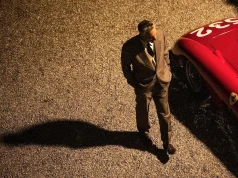
Directed by Steven Spielberg, a longtime fan of the source material, The Adventures of Tintin begins with a gorgeous animated credit sequence, deftly incorporating bits of the narrative about to unfold. It’s as nifty as the overture in Spielberg’s earlier Catch Me If You Can, both scored, with a glancing touch, by his longtime mood generator, composer John Williams. It’s always gratifying to hear what Williams can do when he’s not in attack mode.
Then comes the film proper, which is mostly in attack mode. It is not animation. Nor is it traditional live-action. Working with fellow producer Peter Jackson, who is already set to direct the second Tintin movie, Spielberg goes the 3-D motion capture technology route, wherein actors perform scenes and are then digitally manipulated into a free-form design universe where the laws of physics and derring-do are more spatially expansive. The style builds upon that of Robert Zemeckis’ Polar Express, and other mo-cap features. Sort-of animation, let’s call it.
All those millions, and they still can’t get the teeth or the eyes right with this approach. The whole of Tintin takes place somewhere in the uncanny valley of a dubious creative decision. Much of the action and violence has a clinical, photo-realistic quality, so that a two-second gag involving a cat sinking its claws into a human face elicits a wince rather than a laugh.
For years, Spielberg noodled around with ideas for adapting the comic books about the intrepid young reporter created by Belgian artist Georges Remi, who went by the pen name Herge. The Adventures of Tintin derives mainly from three World War II-era books, The Crab with the Golden Claws, The Secret of the Unicorn and Red Rackham’s Treasure. These titles mean a great deal to Tintin’s European fan base — the film has already made close to a quarter-billion dollars overseas — and less so to the average American multiplex visitor. The script, by Steven Moffat and the team of Edgar Wright and Joe Cornish, follows Tintin (who looks either 12, 22 or somewhere in between) and his faithful dog Snowy as they come into possession of a model sailing ship, the Unicorn, containing a clue to the whereabouts of a vast treasure. Kidnapped and bundled on board a steamship commanded by the career alcoholic Capt. Haddock, our boy-man hero becomes the pawn in an age-old duel between Haddock, a good old sot, and the sinister Sakharine.
Jamie Bell is the actor mo-capped for Tintin; Daniel Craig, unrecognizable, voices and “acts” the bad guy; Andy Serkis, the mo-cap king thanks to his Gollum in The Lord of the Rings and Kong of King Kong, among others, hams it up as Haddock. Unfortunately, the role is a wheeze.
And the film is an extended, exhausting chase. In flashes, Tintin enables Spielberg to dazzle with his set pieces, notably a plane crash in the Sahara, and a motorcycle sequence devised to run the sort-of-animated equivalent of a single, insanely complicated shot.
But I fear Spielberg and Jackson hitched their wagon to the wrong technological star here. Still, those first few minutes are among the most charming of the year. So we can forgive, to a degree, a movie wherein everybody’s face looks like a Botox party gone wild, followed by a wooden-teeth afterparty.
—MCT, Tribune Media Service Respond: [email protected]














